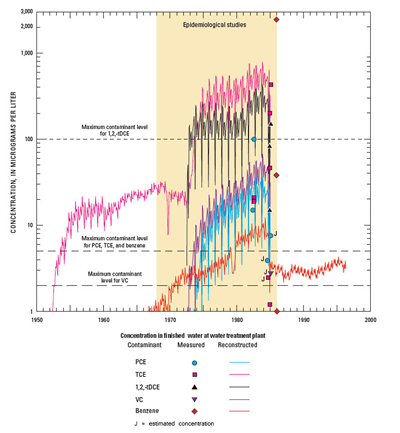What to know
U.S. Marine Corps Base Camp Lejeune, North Carolina was established in 1942. In 1982, the Marine Corps discovered specific volatile organic compounds (VOCs) in the drinking water provided by two of the eight water distribution systems on base.

Background
U.S. Marine Corps Base Camp Lejeune, North Carolina was established in 1942. In 1982, the Marine Corps discovered specific volatile organic compounds (VOCs) in the drinking water provided by two of the eight water distribution systems on base. The Agency for Toxic Substances and Disease Registry has several projects underway to help Marines, civilians, health officials, and other interested parties understand more about the drinking water contamination and whether it affected the health of persons living or working on the base during the period 1968-1985.
Using Research to Understand Health Effects
ATSDR is determining associations between human health effects and exposures to VOCs in drinking (finished) water at Camp Lejeune. To accomplish this, ATSDR used water modeling to determine which areas at Marine Corps Base Camp Lejeune received VOC-contaminated drinking water in the past. Water modeling is a method of analysis that enabled ATSDR to estimate drinking water concentrations for the period 1942-2008. This work will help ATSDR epidemiologists determine what populations were exposed to contaminants and at what levels they were exposed.
Chapter A: Summary and Findings presents summaries of analyses and results of reconstructed VOC-contaminant concentrations in water supply wells and drinking water within the Hadnot Point and Holcomb Boulevard water treatment plant service areas. This report summarizes previous analyses and investigations—Chapters B, C, and D—and results of water modeling investigations. Completing Chapter A and the eight supplements required discovery, extraction, and analyses of data and information from tens of thousands of federal and state government documents.
This report is a companion to previously published reports on geohydrologic data (Chapter B), selected groundwater contaminants at Installation Restoration Program sites (Chapter C), and occurrence of selected groundwater contaminants at above-and underground storage tank sites (Chapter D).
Information in Chapter A
ATSDR's water-modeling techniques and historical reconstruction process were used to estimate monthly contaminant levels in drinking water within the Hadnot Point and Holcomb Boulevard water treatment plant service areas.
ATSDR estimates that drinking water from the Hadnot Point water treatment plant exceeded the current maximum contaminant levels (MCL) for one or more VOCs from August 1953 through January 1985. The specific VOCs that ATSDR examined are:
- trichloroethylene (TCE),
- tetrachloroethylene (PCE),
- trans 1,2-dichloroethylene, (1,2-tDCE)
- vinyl chloride, and
- benzene.
With the exception of trans 1,2-dichloroethylene, these chemicals have been classified as causing or probably causing cancer (carcinogenic). Non-cancer diseases associated with the chemicals are aplastic anemia, infertility, kidney diseases, liver disease, lupus, miscarriage, Parkinson's disease, scleroderma, and skin disorders.
The Hadnot Point Water Treatment Plant opened in 1942 and provided water to both the Hadnot Point and Holcomb Boulevard service areas. The Hadnot Point water system was contaminated with TCE, PCE and refined petroleum products. The Holcomb Boulevard Water Treatment plant came online in 1972. The Holcomb Boulevard system was not contaminated, except for periodic transfers of water from the Hadnot Point Water System.
Within the Hadnot Point service area, drinking water concentrations exceeded the maximum contaminant level (MCL) for trichloroethylene (TCE) from August 1953-January 1985. Reconstructed TCE concentrations in Hadnot Point drinking water reached a maximum level of 783 μg/L during November 1983. The maximum TCE level in Holcomb Boulevard was 66 μg/L in February 1985.The MCL for TCE is 5 μg/L. It was set in 1989.
Within the Hadnot Point service area, drinking water concentrations exceeded the maximum contaminant level (MCL) for tetrachloroethylene (PCE) from August 1974-January 1985. Reconstructed PCE concentrations in Hadnot Point drinking water reached a maximum level of 39μg/L in November 1983. The maximum PCE level in Holcomb Boulevard drinking water was 3 μg/L in February 1985. The MCL for PCE is 5 μg/L. It was set in 1992.

Within the Hadnot Point service area, drinking water concentrations exceeded the maximum contaminant level (MCL) for trans-1,2-dichloroethylene (1,2-tDCE) from November 1972-January 1985. Reconstructed 1,2-tDCE concentrations in Hadnot Point drinking water reached a maximum level of 435 μg/L during November 1983. The maximum 1,2-tDCE level in Holcomb Boulevard drinking water was 33 μg/L in February 1985. The MCL for 1,2-tDCE is 100 μg/L. It was set in 1992.
Within the Hadnot Point service area, drinking water concentrations exceeded the maximum contaminant level (MCL) for vinyl chloride from November 1972-January 1985. Reconstructed vinyl chloride concentrations in Hadnot Point drinking water reached a maximum level of 67 μg/L during November 1983. The maximum vinyl chloride level in Holcomb Boulevard drinking water was 6 μg/L during February 1985. The MCL for vinyl chloride is 2 μg/L. It was set in 1989.
Within the Hadnot Point service area, drinking water concentrations exceeded the maximum contaminant level (MCL) for benzene from January 1979-January 1985. Reconstructed benzene concentrations in Hadnot Point drinking water reached a maximum level of 12 μg/L during April 1984. The maximum benzene level in Holcomb Boulevard drinking water was 3 μg/L during several months in 1972. The MCL for benzene is 5 μg/L. It became effective in 1989.

